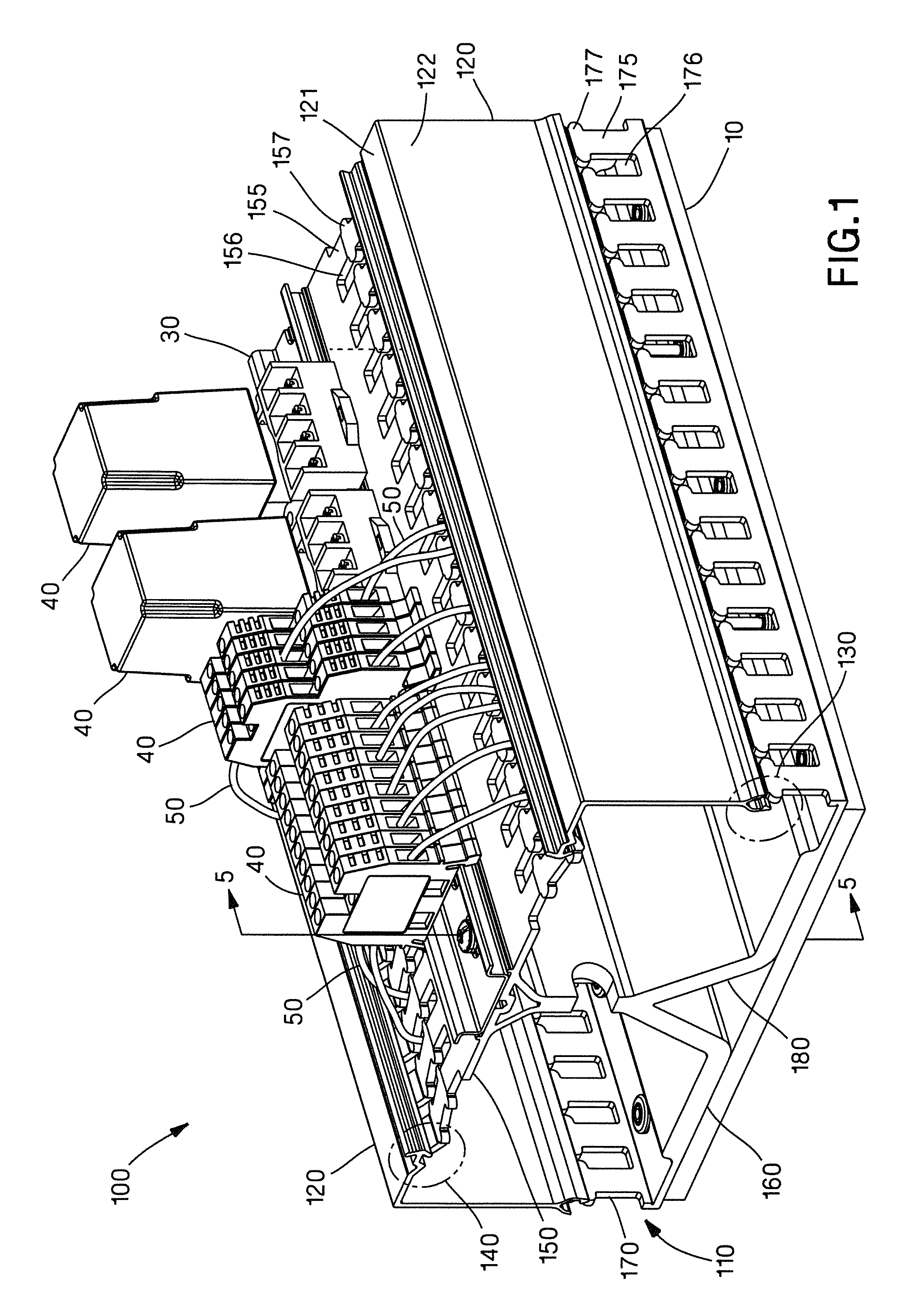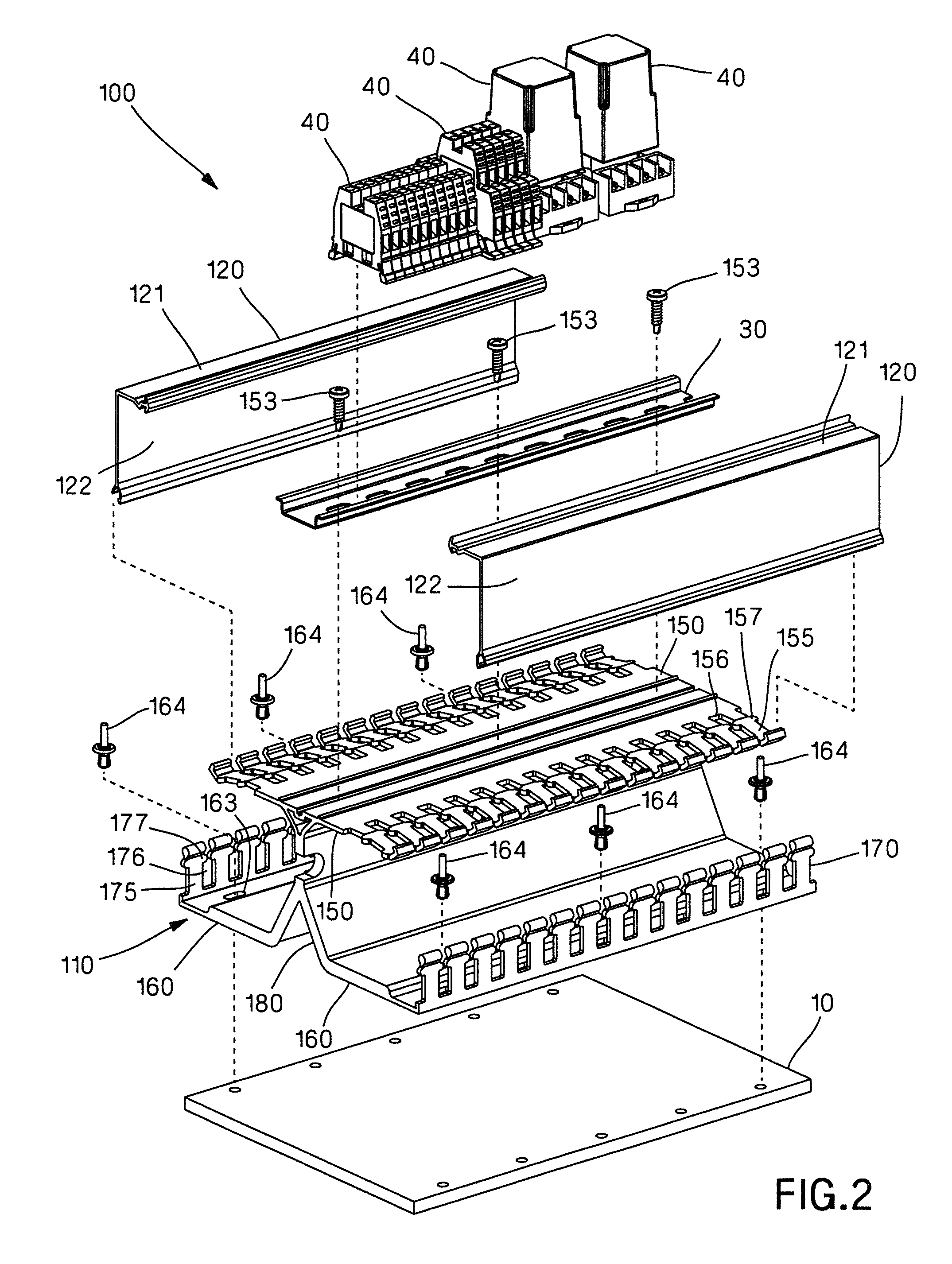Rail wiring duct
- Summary
- Abstract
- Description
- Claims
- Application Information
AI Technical Summary
Benefits of technology
Problems solved by technology
Method used
Image
Examples
first embodiment
[0034]FIGS. 1-10 illustrate a rail wiring duct 100 according to the present invention. The rail wiring duct 100 includes a base 110 and two covers 120. Each of the covers 120 is attached to the base 110 by a hinge mechanism 130 on one side and a latch mechanism 140 on the other side. The rail wiring duct 100 may be formed from any suitable material, but is preferably formed from a plastic material, such as polyvinylchloride (“PVC”). The rail wiring duct 100 is preferably formed by extrusion followed by one or more secondary operations, such as punching of fingers and holes, as necessary.
[0035]As shown in FIG. 1, the rail wiring duct 100 is secured to a backplane 10 of an industrial enclosure (not shown). A DIN rail 30 is secured to the rail wiring duct 100, and DIN rail mounted components 40, such as cube relays, feed through terminal blocks, PLC interface modules, servo control breakout boards, circuit breaker terminal blocks, and / or fused terminal blocks, are secured to the DIN ra...
second embodiment
[0046]FIGS. 14-18 illustrate a rail wiring duct 200 according to the present invention. The rail wiring duct 200 is similar to the rail wiring duct 100 of FIG. 1, except that the rail wiring duct 200 includes an angled, dual hinge-cover 220 and a removable divider wall 280.
[0047]As best seen in FIG. 16, the cover 220 is oriented at an angle A of about 45 degrees with respect to the bottom wall 260 of the base 210. The angle A may be varied from about 0 degrees to about 90 degrees. Varying the angle A of the cover 220 changes the profile of the rail wiring duct 200, which may be advantageous in installations where space is limited.
[0048]As best seen in FIGS. 16-17, each of the covers 220 includes two hinge mechanisms 230, which allow the cover 220 to rotate from a closed position CP, as shown in FIG. 16, to one of two open positions OP1, OP2, as shown in FIG. 17. Additionally, the cover 220 is removable at one or both of the hinge mechanisms 230.
[0049]As best seen in FIG. 18, the top...
third embodiment
[0050]FIGS. 19-23 illustrate a rail wiring duct 300 according to the present invention. The rail wiring duct 300 is similar to the rail wiring duct 100 of FIGS. 1-13, except that the rail wiring duct 300 includes an elevated, dual-hinge cover 320 and an integrally formed, removable top wall 350 and divider wall 380.
[0051]As best seen in FIG. 21, the top wall 350 of the base 310 is substantially U-shaped and includes top wall fingers 355. The top wall fingers 355 are substantially parallel to the sidewall fingers 375 and extend beyond the DIN rail 30. Consequently, the covers 320 are elevated with respect to the DIN rail 30. Compared to the rail wiring duct 100 of FIGS. 1-10, the sidewalls 322 of the cover 320 have been shortened and the sidewalls 370 of the base 310 have been lengthened, although other configurations are likewise contemplated. Additionally, similar to the sidewall fingers 375, the top wall fingers 355 are vertically oriented, and thus, easier to manufacture using ex...
PUM
 Login to View More
Login to View More Abstract
Description
Claims
Application Information
 Login to View More
Login to View More - R&D
- Intellectual Property
- Life Sciences
- Materials
- Tech Scout
- Unparalleled Data Quality
- Higher Quality Content
- 60% Fewer Hallucinations
Browse by: Latest US Patents, China's latest patents, Technical Efficacy Thesaurus, Application Domain, Technology Topic, Popular Technical Reports.
© 2025 PatSnap. All rights reserved.Legal|Privacy policy|Modern Slavery Act Transparency Statement|Sitemap|About US| Contact US: help@patsnap.com



